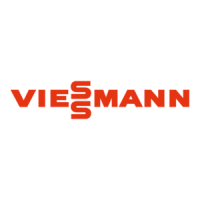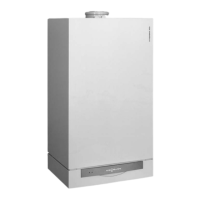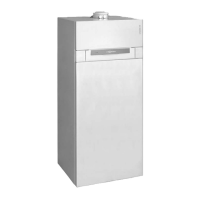
Do you have a question about the Viessmann Vitodens series and is the answer not in the manual?
| Type | Condensing Boiler |
|---|---|
| Fuel Type | Natural gas |
| Efficiency | Up to 98% |
| Heat Exchanger Material | Stainless Steel |
| Control | Vitotronic control system |
| Installation Type | Wall-mounted |
| Model | Vitodens 100-W, Vitodens 200-W |
| Dimensions | Varies significantly by model. Refer to specific model documentation. |
| Weight | Varies significantly by model. Refer to specific model documentation. |
| Modulation Ratio | Up to 10:1 (varies by model) |
| Warranty | Up to 10 years (depending on model and region) |
General safety guidelines for system users to prevent accidents and material losses.
Explanation of hazard symbols like Danger and Please note used in safety instructions.
Critical steps to take if gas is detected, emphasizing immediate danger and actions.
Procedures to follow if flue gas is detected, highlighting risks of poisoning.
Actions to take in case of a fire incident, including system shutdown and using fire extinguishers.
Guidelines for ambient conditions in the boiler room to ensure safe and efficient operation.
Caution regarding the use of non-tested components and requirement for qualified installation.
Information about professional commissioning and notification requirements for new heating systems.
Details on factory default settings for central heating and DHW, and system readiness.
Reference to an appendix chapter for understanding control unit functions and terms.
Recommendations for energy efficiency through proper room temperature, airing, and radiator settings.
Overview of the control unit and room temperature controller, and their adjustment capabilities.
Guide on interpreting the standard display and understanding various system symbols and their meanings.
Step-by-step instructions for initiating the heating system, including pressure checks and power supply.
Procedures for safely shutting down the system, with options for frost protection or complete shutdown.
Checklist of essential settings for central heating, including room temperature and flow temperature.
Instructions on adjusting the heating flow temperature to achieve the desired room temperature.
Guide on selecting the appropriate operating program for central heating based on needs.
Detailed steps for setting time-dependent heating schedules for optimal comfort and efficiency.
Instructions on how to disable central heating while keeping DHW heating active or disabling both.
How to temporarily increase room temperature for guests or special occasions without altering permanent settings.
Essential checks for DHW heating, including temperature, operating program, and time program settings.
Guide on adjusting the hot water temperature to the desired level for domestic use.
Steps to select the operating program for DHW heating, distinguishing between winter and summer modes.
Instructions for creating custom time schedules for hot water availability throughout the day.
Procedures for deactivating DHW heating, either partially with central heating or completely.
Enabling a function to preheat DHW for immediate availability, enhancing user comfort.
Instructions for setting the current time and date, crucial for programming and system operation.
How to switch between Celsius and Fahrenheit for temperature display and settings.
Guide on resetting all user-configured settings back to their original factory defaults.
How to access and view current system operating data, temperatures, and component status.
Instructions for viewing and acknowledging service reminders set by the heating contractor.
How to view error codes, notify the contractor, and acknowledge system faults.
Guidance for operating heating systems with multiple boilers, including control unit interactions and settings.
Procedure for activating emissions test mode, typically performed by a flue gas inspector.
Instructions on how to safely exit the emissions test mode after inspection.
Troubleshooting steps for when the heating system fails to adequately warm the rooms.
Solutions for when the heating system causes rooms to become excessively warm.
Steps to diagnose and resolve issues when hot water is unavailable or not being produced.
Troubleshooting guide for when the domestic hot water temperature is excessively high.
Guidelines for cleaning the heating system components using commercially available domestic cleaning agents.
Information on the necessity and schedule for professional inspection and maintenance of the heating system.
Recommendations for annual cleaning of the boiler to maintain efficiency and prevent energy loss.
Requirements for maintenance and cleaning of the DHW cylinder, advising professional service.
Instructions for checking the safety valve function on the DHW cylinder every six months.
Procedures for maintaining hygiene standards by cleaning or replacing potable water filters.
Definition of operation mode where heating water is constantly heated to a set flow temperature.
Explanation of how operating programs determine heating and DHW provision or system shutdown.
Definition of the sealed circuit for heating water circulation between the boiler and radiators.
Description of the pump responsible for circulating heating water within the heating circuit.
Definition of current temperature readings obtained during system scanning.
Reference to constant temperature operation for boiler water temperature definition.
Explanation of how combustion air is drawn from the boiler room in open flue systems.
Explanation of how combustion air is drawn from outside the building in balanced flue systems.
Definition of the safety device installed to prevent excess pressure in the DHW cylinder.
Definition of the target temperature that the system aims to reach, such as DHW temperature.
Description of the operating mode for warmer months where heating is deactivated, but DHW remains functional.
The circulation pump used for heating domestic hot water within the DHW cylinder.
A device installed to remove solids from water, typically upstream of the DHW cylinder.











